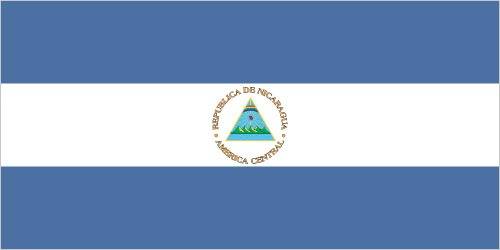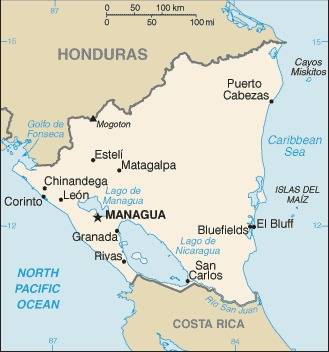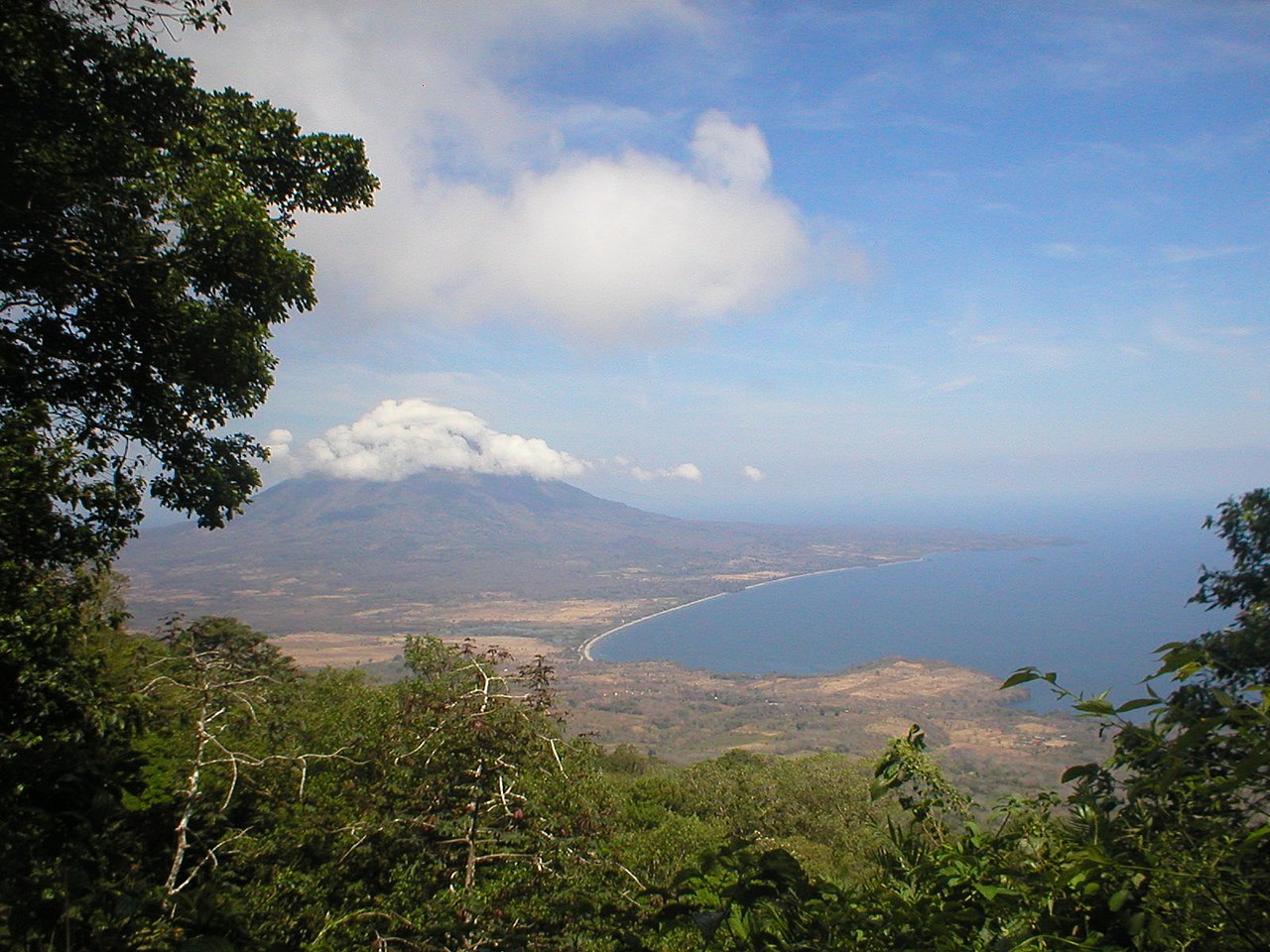26 Nicaragua

Three equal horizontal bands of blue (top), white, and blue with the national coat of arms centered in the white band. The coat of arms features a triangle encircled by the words REPUBLICA DE NICARAGUA on the top and AMERICA CENTRAL on the bottom. The banner is based on the former blue-white-blue flag of the Federal Republic of Central America. The blue bands symbolize the Pacific Ocean and the Caribbean Sea, while the white band represents the land between the two bodies of water.
Flag courtesy of the CIA World Factbook

Map courtesy of CIA World Factbook

Nicaragua is known as “the land of lakes and volcanoes”; pictured is Concepción volcano, as seen from Maderas volcano.
Photo courtesy of the Wikipedia
Government
According to Britannica, from 1838, when Nicaragua seceded from the United Provinces of Central America, to 1979, when the long dictatorial reign of the Somoza family came to an end, Nicaragua had nine constitutions. The Somoza regime was deposed in 1979 by a junta, led by the Sandinistas, which abrogated the old constitution and suspended the presidency, Congress, and the courts. An elected president and unicameral National Assembly replaced the junta and its appointed council in 1985, and a new constitution (the country’s 10th since 1838) was promulgated in 1987, with reforms in 1995, 2000, and 2005. The president is elected by popular vote for a five-year term; in 2009 the Nicaraguan Supreme Court lifted a constitutional ban on consecutive reelection, allowing the incumbent president to serve an additional term in office. Assembly terms are five years and run concurrently with the presidential term. Power is divided among four governmental branches: executive, legislative, judicial, and electoral. The last mentioned is the Supreme Electoral Council, which is responsible for organizing and holding elections.
Nicaragua is divided into regiones (regions), which are subdivided into departamentos (departments). Within the departments are municipios (municipalities) of varying sizes. Citizens of the municipalities directly elect a municipal council, which has basic governing authority and also elects the mayor. The municipal councils are responsible for urban development; land use; sanitation; construction and maintenance of roads, parks, and other public spaces; and cultural institutions within their own municipality. There are two autonomous indigenous regions on the Caribbean coast—the North Atlantic Autonomous Region and the South Atlantic Autonomous Region, whose respective capitals are Puerto Cabezas (Bilwi) and Bluefields.
Nicaragua’s judicial system includes civilian and military courts. The Supreme Court is the country’s highest court. Its justices, who are elected to seven-year terms by the National Assembly, are responsible for nominating judges to the lower courts. Nicaragua’s judicial system has received international assistance through judicial reform projects, but it continues to be plagued by inconsistent decisions, trial delays, and politicization.
Nicaraguan Institute of Civil Aeronautics (INAC)
The Nicaraguan Institute of Civil Aeronautics (INAC) is an autonomous technical and specialized entity that functions as the Civil Aviation Authority (CAA). It was born after the approval in October 2006 of the General Law of Civil Aeronautics (Law 595) as successor without solution of continuity of the General Direction of Civil Aeronautics (DGAC) previously assigned to the Ministry of Transport and Infrastructure (MTI). It is responsible for the regulation, supervision, control and enforcement of the rules governing air transport services and all aeronautical activities that take place within the national territory, its airspace and the one surrounding its jurisdictional waters (Law 595, Title II , Chapter I Art.9). Consistent with our mission and vision, INAC makes an important contribution to the development of Nicaraguan civil aviation, providing training and constant updating to its technical, specialized and administrative-financial personnel, in accordance with the demands, advances and evolution of the national and international aeronautical sector.
Airspace
SkyVector – Google Maps – ADS-B Exchange
ICAO countries publish an Aeronautical Information Publication (AIP). This document is divided into three parts: General (GEN), En Route (ENR) and Aerodromes (AD). ENR 1.4 details the types of airspace classes they chose to adopt from classes A through G.
COCESNA
The Central American Corporation for Air Navigation Services (COCESNA) is an International Organization for Central American Integration, non-profit and public service, with legal status and financial autonomy, created on February 26, 1960 and governed by a Board of Directors, which it is constituted in its highest collegiate body, which is made up of the representatives of the signatory States of its Constitutive Agreement; established with well-defined objectives and purposes to respond and jointly comply with civil aviation international commitments contracted as signatory countries of the Convention on International Civil Aviation of 1944, known as the Chicago Convention. In that order, COCESNA enjoys the exclusive rights to provide Air Traffic, Aeronautical Telecommunications and Radio Assistance services in the territories of the Member States and other services established in the regional plans that have been entrusted to it by the Contracting Parties. under an international agreement. Its operations are fundamentally based on the Standards and Methods recommended by the ICAO. The adherence to the established norms and the search for excellence constitute COCESNA’s fundamental objectives.
As a result of the notable progress in aviation at the end of the 1950s, especially with the entry into service of jet aircraft, the need to modernize and strengthen the region’s air navigation services was valued, for which, in the month November 1959, a meeting with the Directors was held in Guatemala. Generals of Civil Aeronautics of Central America at that time, within which it was agreed to convene a Diplomatic Conference aimed at establishing a specialized regional organization, with the necessary human and financial resources to meet these modern requirements, as well as to unify and coordinate regional intergovernmental efforts and actions that would benefit the users of these services. Therefore, from February 22 to 26, 1960, the V Conference of Directors of Civil Aeronautics was held in Tegucigalpa, Honduras, signing the guidelines of the Central American Corporation of Air Navigation Services -COCESNA, thus marking the beginning of its existence and operation. Consequently and by virtue of its nature, on February 1, 1961, its Constitutive Agreement was registered with the International Civil Aviation Organization – ICAO and on January 2, 1962 with the United Nations (UN). During the year 1963, COCESNA acquires the official recognition of the States of the Central American isthmus, through decrees and laws that ratified its Constitutive Agreement issued by the Legislative Assemblies of each Member State. Nicaragua is a member state of COCESNA.
Drone Regulations
2021.04.23 – INAC holds a virtual meeting of the UAS-Drones working group – Managua, Nicaragua
Alert: Criminal Penalties Possible for Drone Ownership in Nicaragua (December 19, 2024)
Advanced Air Mobility (AAM) Regulations & Policies
None found by the author.
However, should you, the reader, happen to stumble across something to the contrary, please email the author at FISHE5CA@erau.edu and you may be mentioned in the ACKNOWLEDGEMENTS section of this book by way of thanks for contributing to this free eBook!
Advanced Air Mobility (AAM) News
None found by the author.
However, should you, the reader, happen to stumble across something to the contrary, please email the author at FISHE5CA@erau.edu and you may be mentioned in the ACKNOWLEDGEMENTS section of this book by way of thanks for contributing to this free eBook!
Short Essay Questions
Scenario-Based Question
You have been hired by a Drone Startup Company. Your boss has immediately assigned this job to you.
They need you to prepare a one-page memo detailing the legalities of using a drone at the volcano, pictured above.
They need you to mention any national laws and local ordinances.
They specifically want to know what airspace (insert pictures) you will be operating in and whether or not you need an airspace authorization.
Does it matter whether or not you are a citizen of the country?
Lastly, there is a bonus for you if, as you scroll through this chapter, you find any typos or broken links!
Short Essay Questions
- What are the drone categories?
- How is registration addressed?
- How is remote ID addressed?
- What are the model aircraft rules?
- What are the commercial drone rules?
- Are there waivers or exemptions to the rules? If so, for what?
- Would you share a link to an interactive airspace map?
- How is BVLOS addressed?
- How can you fly drones at night?
- How can you fly drones over people?
- Where do you find drone NOTAMs?
- What are the rules for drone maintenance?
- What are the rules for an SMS program?
- What are some unique rules not mentioned above?
- What are the C-UAS rules?
- What are the AAM rules?

